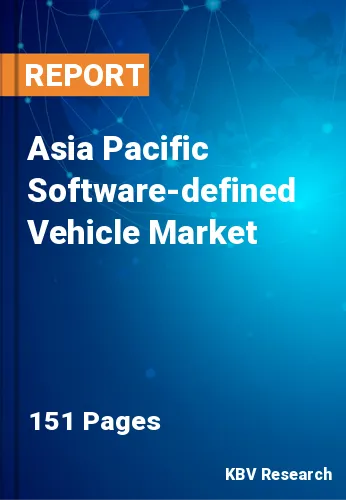The Asia Pacific Software-defined Vehicle Market would witness market growth of 10.9% CAGR during the forecast period (2023-2030).
In an increasingly connected world, consumers expect their vehicles to be an extension of their digital lives. The demand for seamless integration of smartphones, access to apps, and constant connectivity has pushed automakers to embrace software-defined approaches. Automotive manufacturers and fleet operators are recognizing the cost-saving potential of software-defined vehicles. Remote updates, predictive maintenance, and streamlined fleet management reduce downtime and operational costs. As environmental concerns take center stage, a growing push for more sustainable transportation is growing. It can optimize driving patterns, reduce emissions, and enable electric and hybrid vehicles to operate at their most efficient levels.
The shift towards electric vehicles (EVs) and autonomous driving is closely intertwined with software-defined vehicles. As EVs become mainstream, software is pivotal in managing battery efficiency, charging, and range optimization. Autonomous vehicles rely on complex software stacks for perception, decision-making, and control. The risk of cyberattacks has grown significantly due to the increasing complexity of vehicle software systems. Protecting vehicles from hacking and ensuring the safety of passengers is a top priority. Innovations in automotive cybersecurity are an integral part of this market's development. Artificial intelligence and machine learning algorithms are driving advancements in software-defined vehicles. These technologies enable features such as predictive maintenance, natural language processing for voice commands, and the ability to learn and adapt to individual driver behaviours.
Japanese automakers have a long history of innovation and engineering excellence. Japanese automakers have a long history of innovation and engineering excellence. Japanese automakers are developing software-defined powertrains for their electric and hybrid vehicles. Japanese automakers are actively working on enhancing vehicle connectivity. Japanese automakers provide telematics services that offer real-time data on vehicle diagnostics, driver behaviour, and location. Additionally, in 2021, according to the Japan Automobile Dealers Association (JADA), 3,675,650 new cars were sold, of which 40,5% were electric vehicles. The factors mentioned above will drive the regional market growth.
The China market dominated the Asia Pacific Software-defined Vehicle Market, by Country in 2022, and would continue to be a dominant market till 2030; thereby, achieving a market value of $56,246.5 million by 2030. The Japan market is exhibiting a CAGR of 10.1% during (2023 - 2030). Additionally, The India market would experience a CAGR of 11.6% during (2023 - 2030).
Based on Offering, the market is segmented into Hardware, Software, and Services. Based on Application, the market is segmented into ADAS/HAD, Powertrain & Chassis, Infotainment, Connectivity & Security, and Body & Energy. Based on Vehicle Type, the market is segmented into ICE, BEV, and HEV/PHEV. Based on countries, the market is segmented into China, Japan, India, South Korea, Singapore, Malaysia, and Rest of Asia Pacific.
Free Valuable Insights: The Global Software-defined Vehicle Market is Predict to reach USD 510.4 Billion by 2030, at a CAGR of 10.5%
The market research report covers the analysis of key stake holders of the market. Key companies profiled in the report include Robert Bosch GmbH, Continental AG, Valeo SA, Aptiv PLC, Marelli Holdings Co., Ltd., Tesla, Inc., NVIDIA Corporation, Volkswagen AG, Harman International Industries, Inc. (Samsung Electronics Co., Ltd), BlackBerry Limited, Medtronic PLC
By Offering
By Application
By Vehicle Type
By Country
Our team of dedicated experts can provide you with attractive expansion opportunities for your business.

